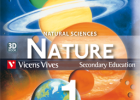The Earth's Crust
There are two large important areas on the surface of our planet: the continents, which constitute solid ground, and the seas and oceans. The continents and the ocean floor are formed of rocks. These rocks are made up of minerals. Rocks and minerals are very important. We extract metals, fuels and other natural materials from rocks for industry and construction. Natural resources, however, are limited. [...]
Esta secuencia contiene:
-
11 actividades
-
99 recursos
-
Idioma:
- Inglés
-
Formato:
Interactivo
Secuencia didáctica
-
Didactic objectives Know the process of formation of the different elements that go to form the Earth's surface. Describe the principal chemical components that constitute the surface of the Earth’s crust. [...]
-
1. The Earth's crust The crust is the most superficial layer of the Earth. There are two different areas on the surface of the Earth's crust: continents and oceans. Continents are the raised regions of the Earth's surface. [...]
-
There are two large important areas on the surface of our planet: the continents, which constitute solid ground, and the seas and oceans. The continents and the ocean floor are formed of rocks. These rocks are made up of minerals. [...]
-
1.1. The surface of the crust The crust is the most superficial layer of the Earth. There are two different areas on the surface of the Earth's crust: continents and oceans. Continents are the raised regions of the Earth's surface. [...]
-
2.1. What is a mineral? Minerals are solid and inorganic substances which have a particular chemical composition. They are formed naturally. [...]
-
3.1. Mineral properties Mineralogy is the science of studying minerals. Minerals can be identified according to their physical and chemical properties. [...]
-
Precipitates Many minerals are formed by precipitation. This occurs when water evaporates or when dissolved substances stop being soluble and fall to the bottom of the sedimentary basin. [...]
-
4.1. What is a rock? A rock is a material made up of minerals. The majority of rocks, such as granite and basalt, are made up of many different minerals. Other rocks, such as salt, are made up of only one mineral. [...]
-
5.1. Igneous rocks Igneous rocks are formed from the magma inside the Earth. There are two main groups: Plutonic rock. This forms deep below the Earth's crust when the magma slowly solidifies. [...]
-
There are two large important areas on the surface of our planet: the continents, which constitute solid ground, and the seas and oceans. The continents and the ocean floor are formed of rocks. These rocks are made up of minerals. [...]
-
There are two large important areas on the surface of our planet: the continents, which constitute solid ground, and the seas and oceans. The continents and the ocean floor are formed of rocks. These rocks are made up of minerals. [...]
Cursos y asignaturas
-
12 años:
- Biología
- Geologia
-
13 años:
- Biología
- Geologia
-
Aún no hay comentarios, ¡comparte tu opinión! Inicia sesión o Únete a Tiching para poder comentar
La licencia digital es una autorización que permite utilizar un recurso digital de acuerdo con las condiciones legales de dicho recurso. El código que recibas una vez la hayas comprado te permitirá acceder al recurso educativo digital elegido.
Puedes consultar más información en nuestra página de ayuda.












































































































¿Dónde quieres compartirlo?
¿Quieres copiar el enlace?